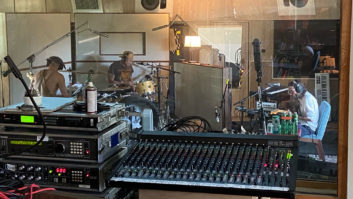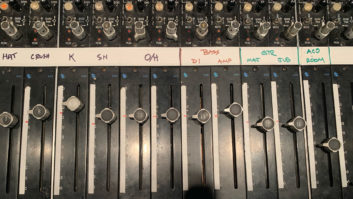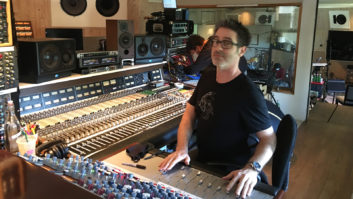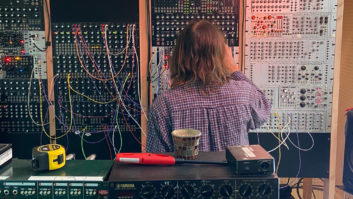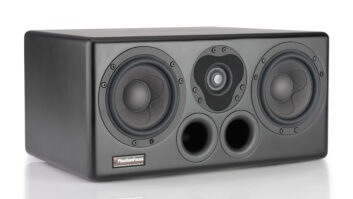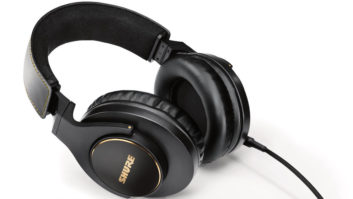
Inductee Flea, of the Red Hot Chili Peppers, performs on stage at the 27th Annual Rock And Roll Hall Of Fame Induction Ceremony at Public Hall on April 14, 2012 in Cleveland, Ohio.
Photo: Jeff Kravitz/FilmMagic
Over his 20 years of mixing the Red Hot Chili Peppers, Dave Rat of Rat Sound Systems has had to deal with a wide range of audio issues. During the current multi-year tour in support of the album I’m with You, the band encountered severe interference issues with its IEM system, which Rat addressed with a switch to the Shure PSM 1000 system and its diversity reception design.
“The troubles we were having with our existing in-ear systems were primarily due to the LED stage we have on this tour,” Rat explains. “We experienced a whole new level of interference issues. When you have the artists actually standing on an LED surface, it means the beltpack is only three feet away from the RF noise, while the transmitting antenna is maybe 30 feet away. The result was a lot of dropouts from a system that had previously been very stable. We couldn’t even do frequency scans from the stage.”
Working with the experts at Professional Wireless Systems, Rat tried a number of techniques to address the issue, including increased RF output, an improved antenna system, and a new frequency scheme. “We could get it better, but nothing we tried was good enough,” Rat recalls. “So we decided to give the Shure PSM 1000 a try. Immediately, we saw a huge improvement. Dropouts were virtually eliminated, and the improved filtering on the diversity receivers lets us scan from the stage again.
“Obviously, wireless performance was the main benefit,” says Rat. “But in addition, the sound quality was distinctly better, which is obviously the main job of an in-ear system. In fact, when Anthony [Kiedis] tried the system, he came up and commented on how great it sounded—and he very rarely says anything about audio. I got that from a couple other guys in the band as well.”
Monitor engineer Tim Engwall sets up and operates the IEMs each day. “Now that we have the PSM 1000, I can do a frequency scan from the stage again,” he reports. “Every day, I go onstage, put a bodypack in full scan mode and set up all the frequencies fresh. The system gives me the best group and the cleanest channels, then I sync the channels and walk the room. I listen with pink noise going through the packs, and with nothing going through them, just to make sure everything sounds good all over the stage. Everything’s been working great since we made the change.”
Currently, Red Hot Chili Peppers are touring with eight channels of PSM 1000. Of the six artists onstage, five are on PSM 1000 systems. “The guitarist, Josh Klinghoffer, is on wedges and sidefills, so his channel is actually used by his guitar tech,” says Engwall. “Then we have one system for me, and one spare we can use for a guest artist.”
Rat also says that the ability to set up the bodypack receivers in an artist-friendly way was a beneficial feature of the PSM 1000. “The band members really want to see that volume pot on their bodypack at two o’clock. That’s what they’re used to, and that’s what feels right to them,” he says. “Obviously, if you change systems, that value may change. But Shure actually gives you the ability to change the sensitivity of the volume pot on the bodypack, so nothing changes from the artist’s perspective. That was huge for us. It’s kind of like me setting up my console so I can keep all my faders around 0 dB. It puts you in your comfort zone during the show.”
Rat also appreciated the PSM 1000 system’s gain structure and headroom. “In the past, we’ve run into headroom issues with in-ear systems, where it was difficult to get the volume we needed out of the beltpack without overloading the input,” he notes. “That’s not a problem with the PSM 1000. The gain structure of the system is easily the best we’ve ever used.”
Monitor engineer Tim Engwall agrees. “I like to mix my outputs pretty hot, and the PSM system lets me bump it down on the front side, then use the high output on the back side to give the band the volume they need without any overload. That gives me enough dynamic range so that I can actually mix again, to let things pop out instead of just slamming everything to the top. That was huge for me.”
“Any equipment change comes with trade-offs, like the second antenna you need on a diversity receiver,” Rat concludes. “But for our application, the technical advantages of the PSM 1000 made it the right choice. First, it solved our wireless problem. Second is reliability, and we’ve had nothing go wrong with them—zero failures. Then there’s the sound quality, which the band loves. As people figure out that the PSM 1000 actually sounds better, I think we’ll be seeing a lot of them out on tour.”
Find more information on the Shure PSM 1000.

